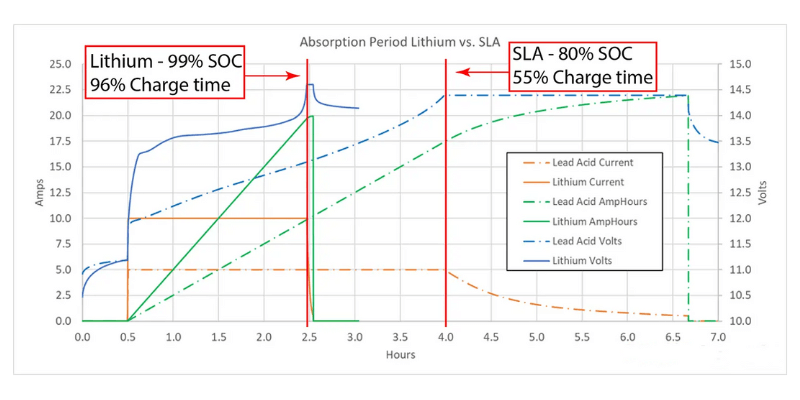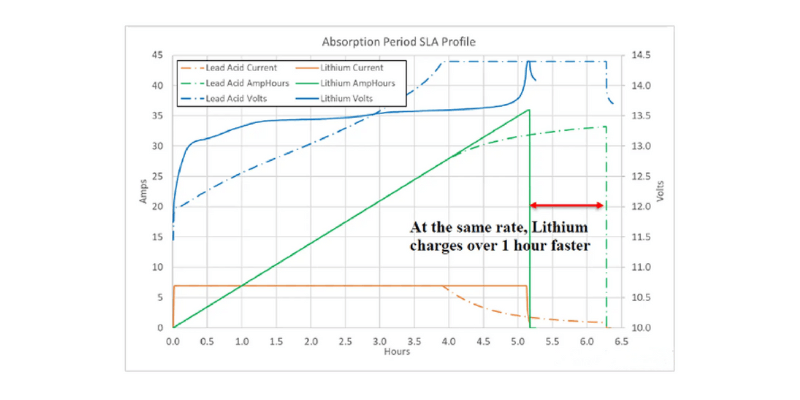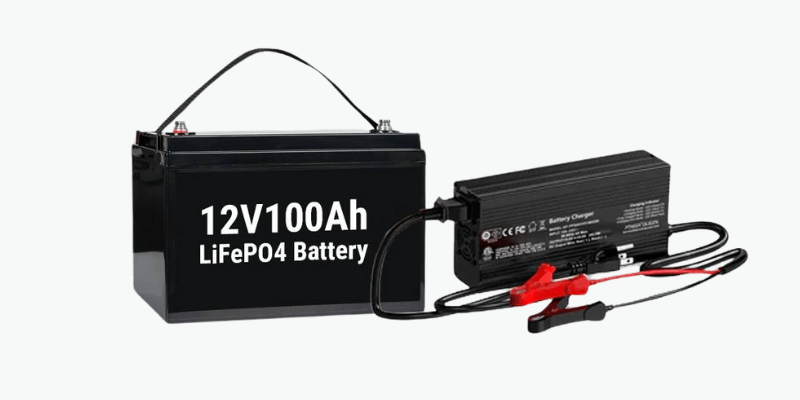Les batteries au lithium chargent beaucoup plus rapidement que les batteries de plomb scellées (SLA). Vous vous demandez peut-être combien plus rapide et ce que cela signifie pour vous en tant qu'utilisateur final. Un chargeur SLA ordinaire peut-il être utilisé pour charger une batterie au lithium?
Charging Absorption Différences entre le SLA et le lithium
Chargement d'une batterie SLA peut prendre du temps. Par exemple, une batterie SLA à cycle profond de 12 volts de 20 volts a mis environ 6,5 heures pour atteindre une charge complète, tandis qu'une batterie de phosphate de fer au lithium de 20,8 volts de 20 volts a obtenu une charge complète en un peu plus de 2,5 heures.

Un cycle de charge pour les batteries SLA se compose de trois étapes: courant constant, tension constante et charge flottante.
Dans le stade de courant constant, une batterie SLA à cycle profond de 20h atteint un état de charge de 80% (SOC). L'étape de tension constante complète les 20% restants, prenant environ 50% du temps de charge total.
Enfin, une charge flottante est maintenue pour empêcher la désintégration excessive de l'auto-décharge.
Un cycle de charge de lithium se compose de deux étapes: courant constant et tension constante.
Au stade de courant constant, la batterie atteint une capacité de 99% (SOC de 99%) dans 96% du temps de charge. Une batterie au lithium de 12,8 V 20Ah charge presque complètement en moins de deux heures. L'étape de tension constante ajoute seulement 1%, ne prenant que 4% du temps de charge.
De plus, les batteries au lithium n'ont pas besoin de charges flottantes en raison de leur faible taux d'auto-décharge.
Absorption au lithium sur un profil de charge SLA
Lorsque l'on considère une batterie de lithium en remplacement de rendez-vous pour une batterie SLA avec un chargeur SLA, il est important de comprendre les effets potentiels.
La charge d'une batterie au lithium sur un chargeur SLA à 13,8 V lui permet d'atteindre une capacité de 95% dans environ 90% du temps de charge, tandis qu'à 14,6 V, il atteint 99% en 95% du temps.
Le chargement d'une batterie de lithium sur un profil SLA augmente le temps d'environ 2,5 heures (en utilisant un profil de lithium) à 5 heures. Cependant, comme indiqué dans le graphique ci-dessous, la batterie au lithium charge toujours plus rapidement qu'une batterie SLA équivalente sur un profil SLA.

Vous pouvez utiliser des batteries au lithium dans un chargeur SLA s'il manque de mode de dé-sulfation ou de caractéristiques de détection de batterie mortes. Les impulsions de dé-sulfation peuvent endommager ou arrêter le BMS de la batterie au lithium, et les détecteurs de batterie morts peuvent mal interpréter une batterie de lithium protégée comme mort.
Les chargeurs SLA fonctionnent généralement à des tensions comprises entre 13,8 V et 14,7 V, permettant aux batteries de lithium de se charger plus rapidement que les SLA. Les batteries au lithium atteignent une charge complète plus rapidement et atteignent des états de charge plus élevés dans cette plage de tension.
Un chargeur SLA normal endommagera-t-il une batterie de lithium?
L'utilisation d'un chargeur SLA sur une batterie au lithium peut être acceptable, surtout si elle n'a pas de mode dé-sulfate.
Dans les applications de cyclisme quotidiennes, la dégradation est peu probable, bien que la batterie de lithium puisse ne pas atteindre la pleine capacité (par exemple, une batterie au lithium de 20h peut ne pas atteindre 20 ampères avec un chargeur SLA). S'il est rarement utilisé et laissé au flotteur pendant de longues périodes, il est préférable de déconnecter la batterie avant le stockage.
Les batteries au lithium fonctionnent de manière optimale à 50% d'état de charge (SOC). Holo Battery recommande d'utiliser des chargeurs adaptés à la chimie de chaque batterie et de vérifier les batteries au lithium pour une basse tension tous les 3 à 4 mois.

